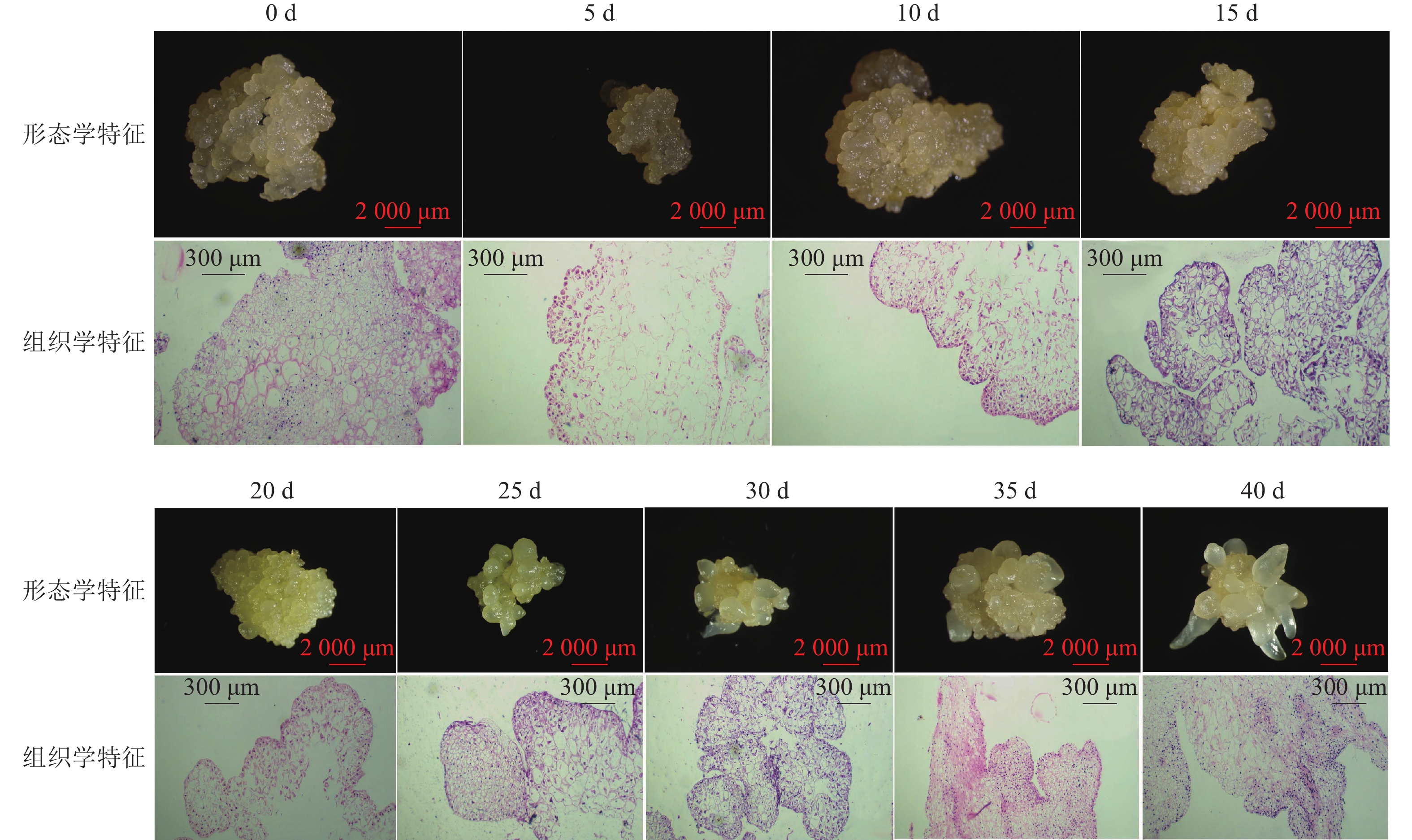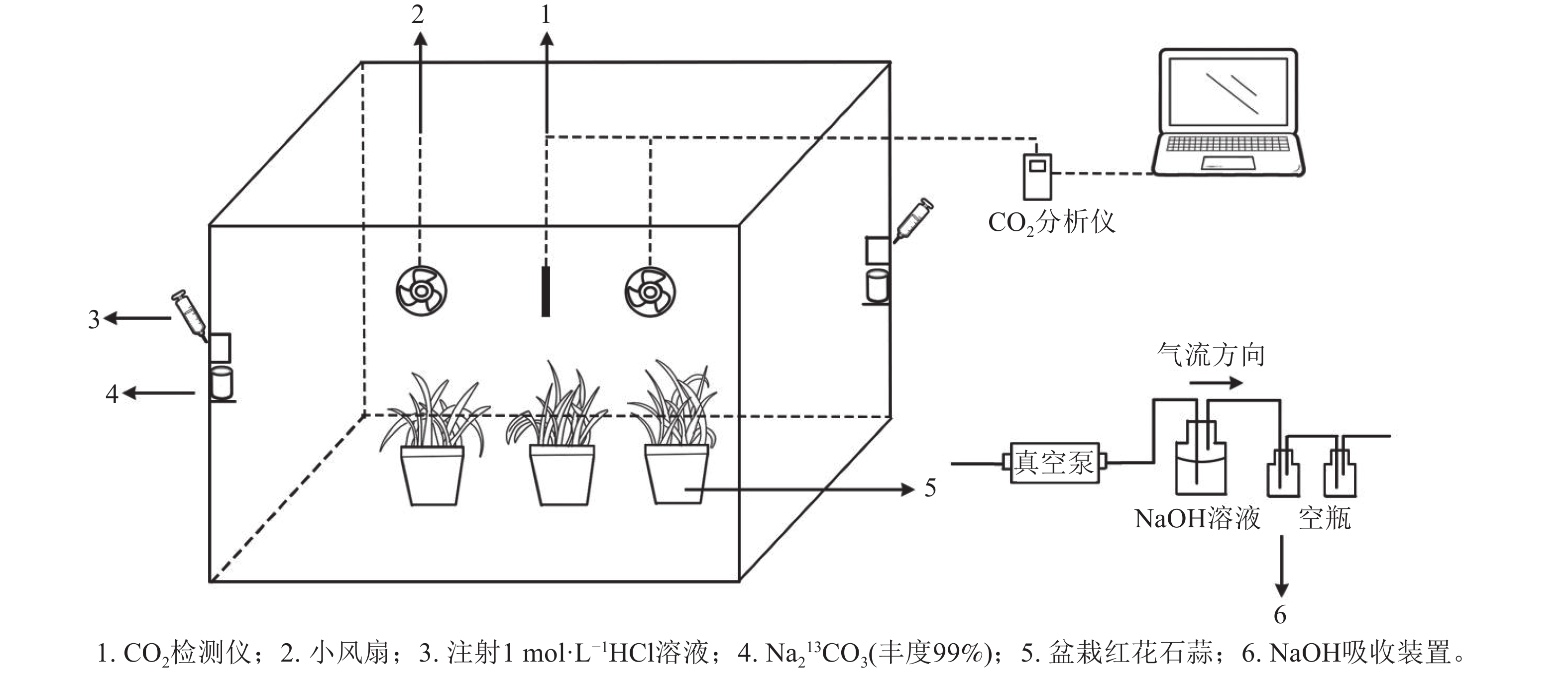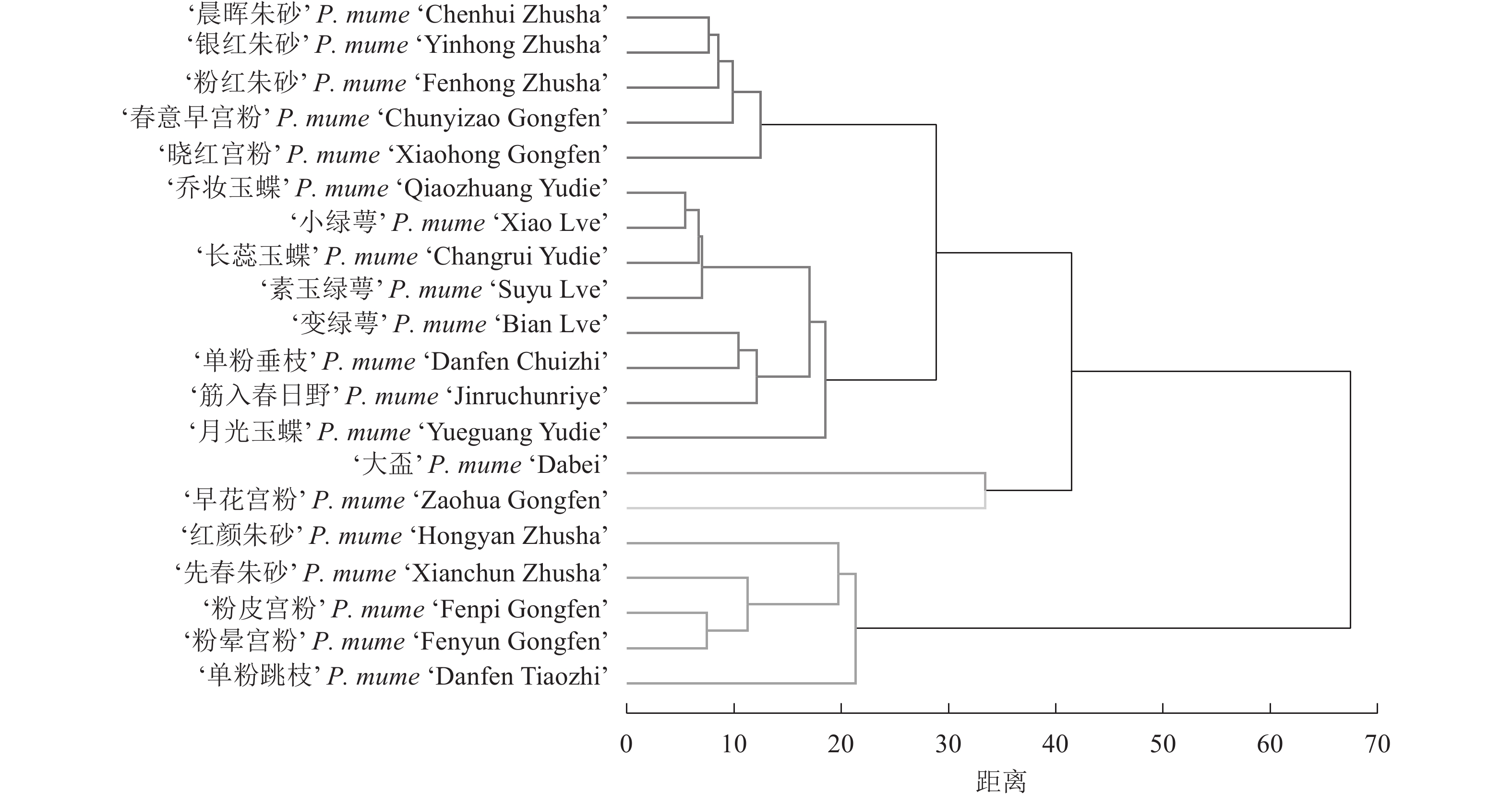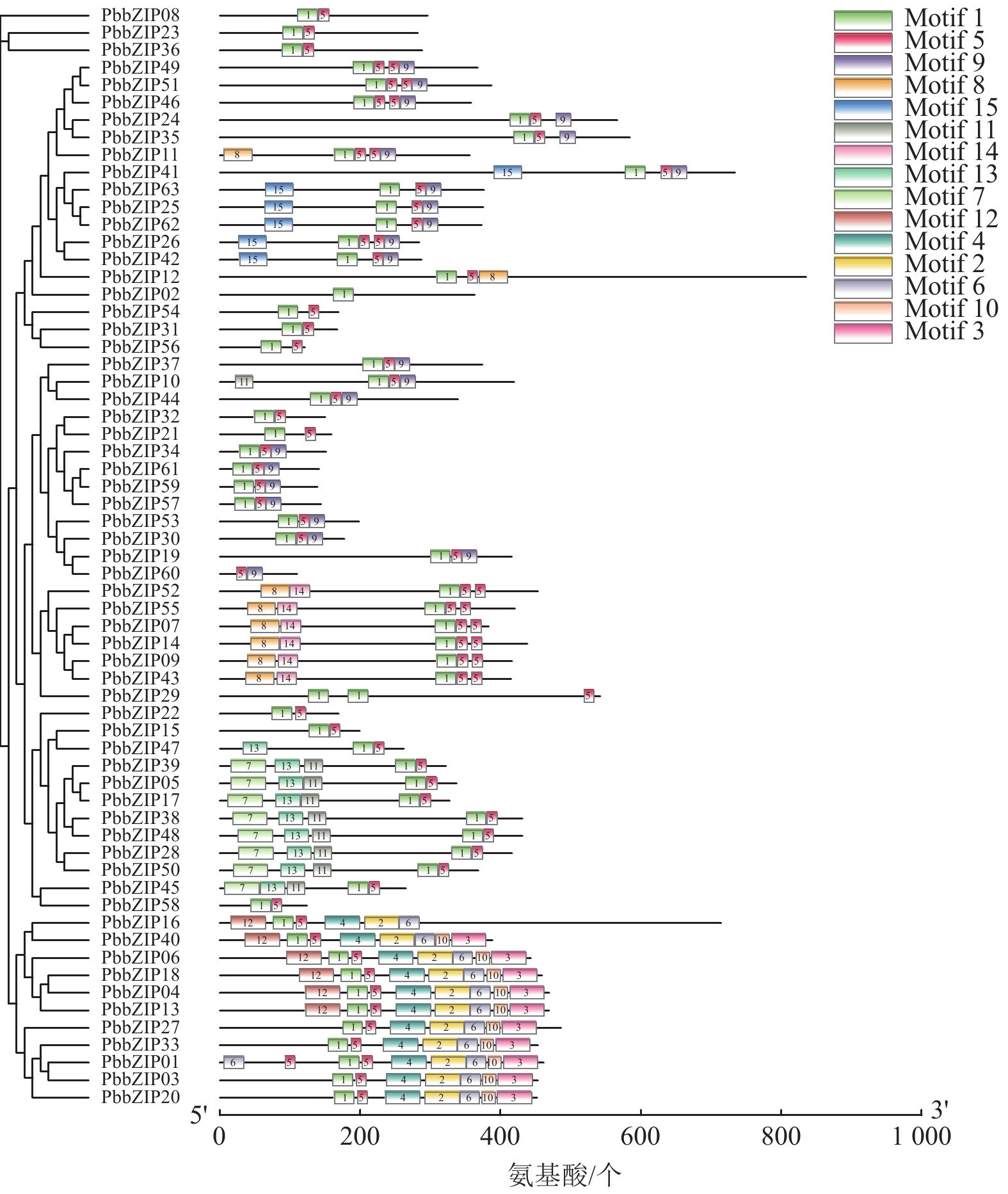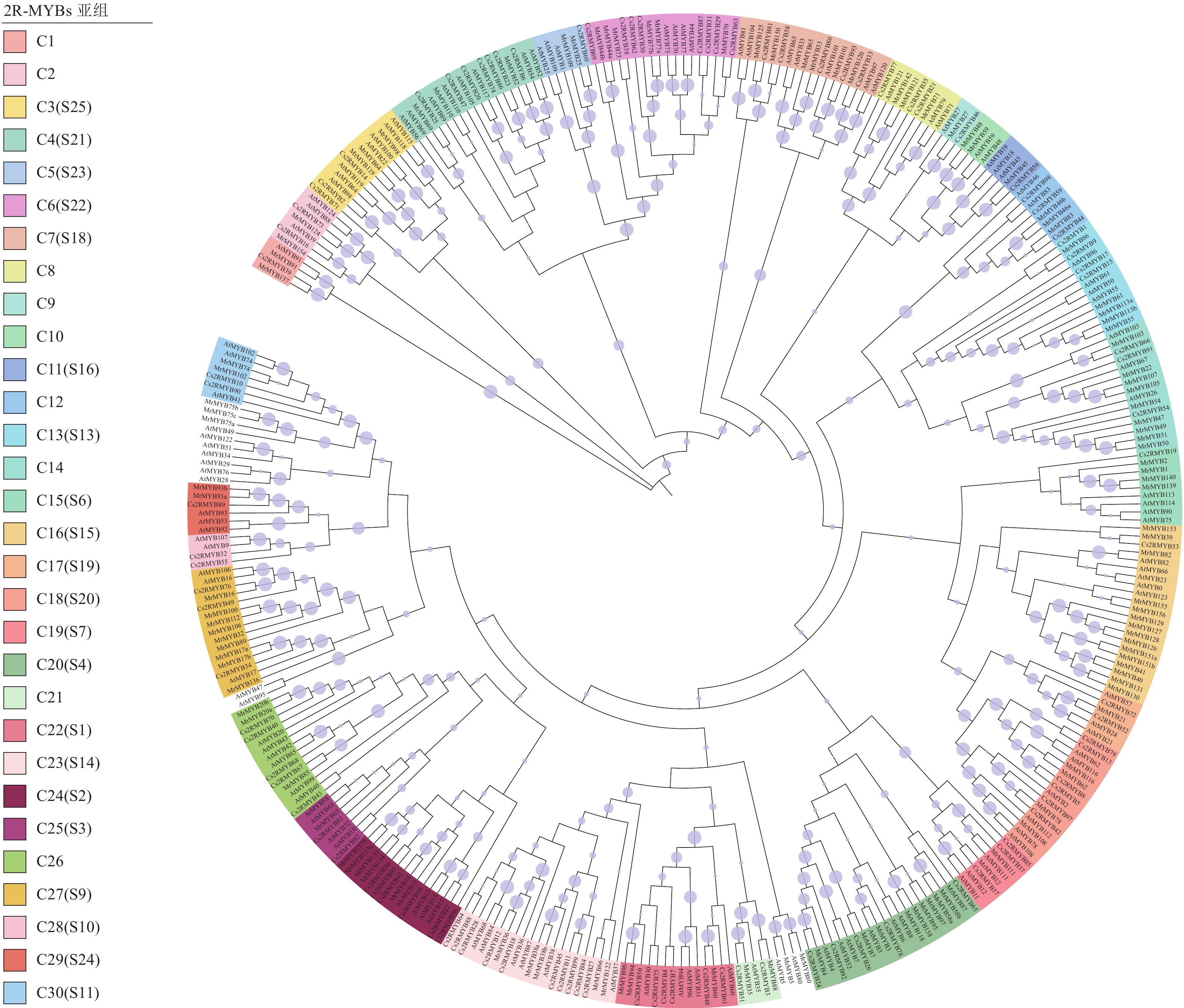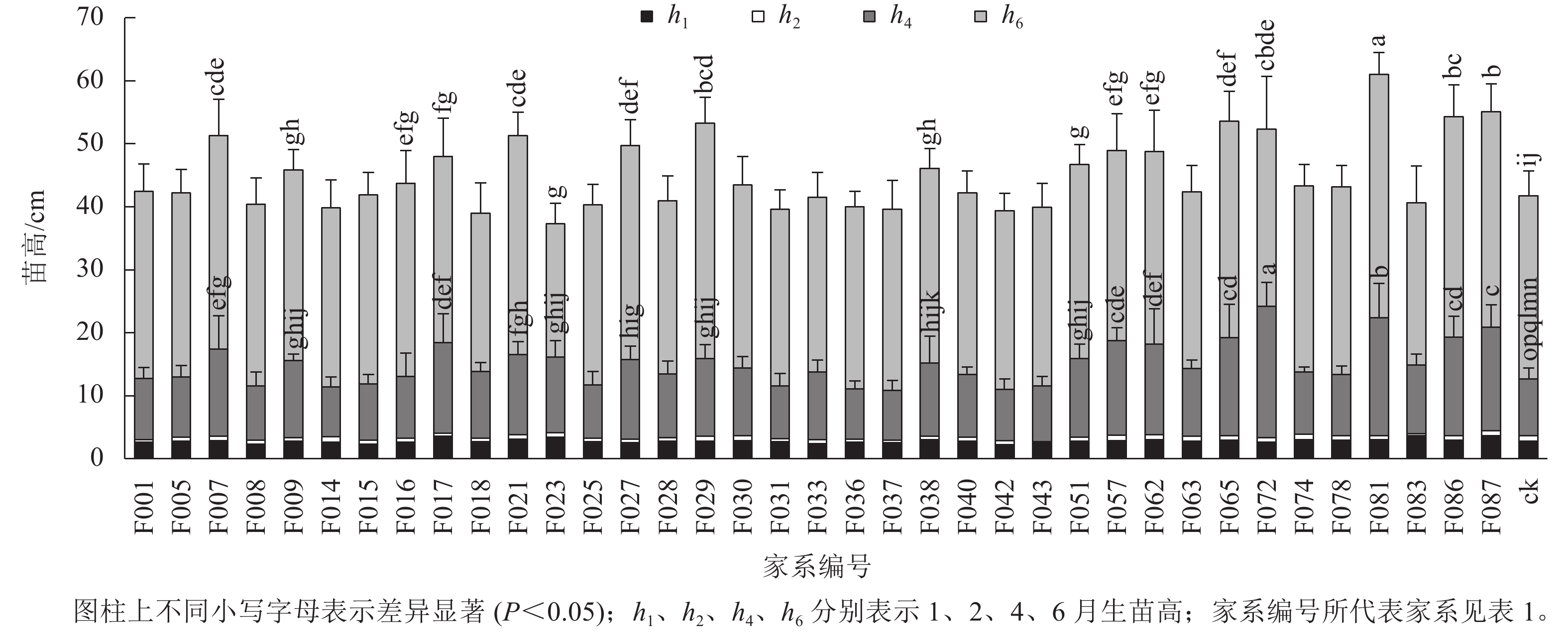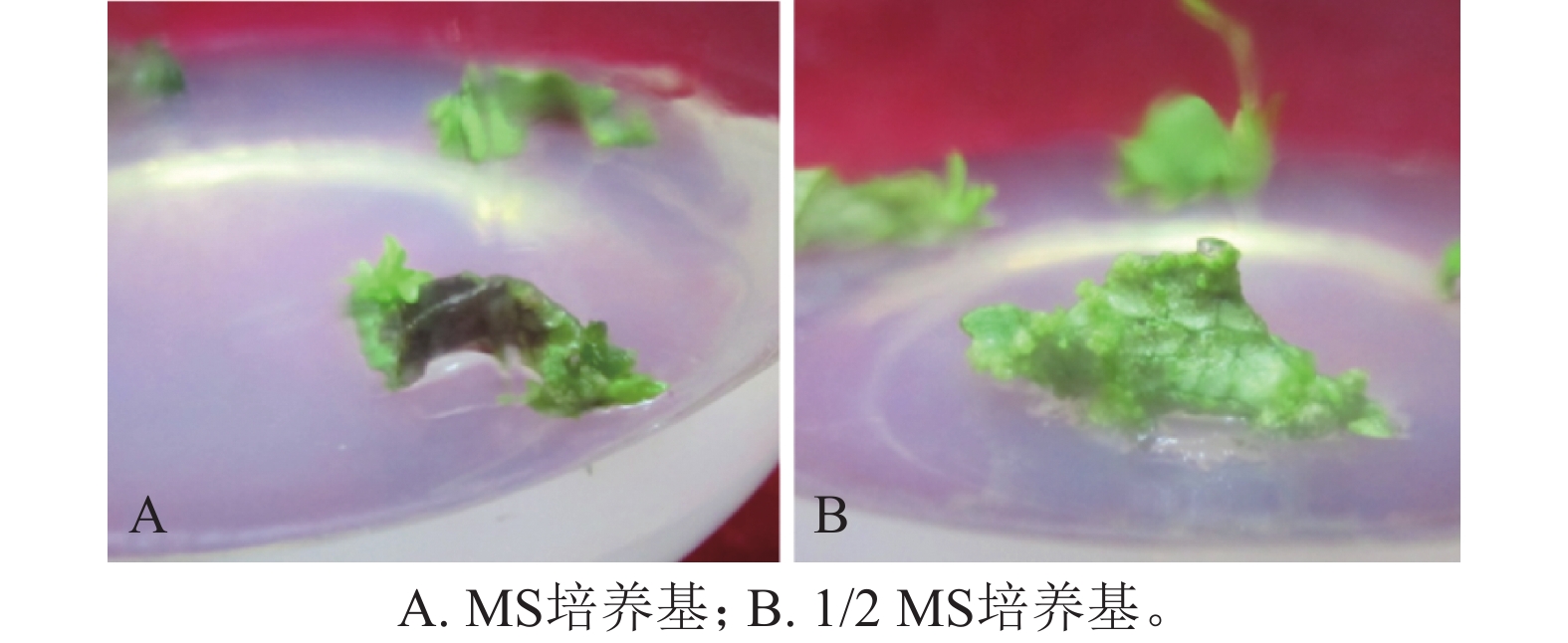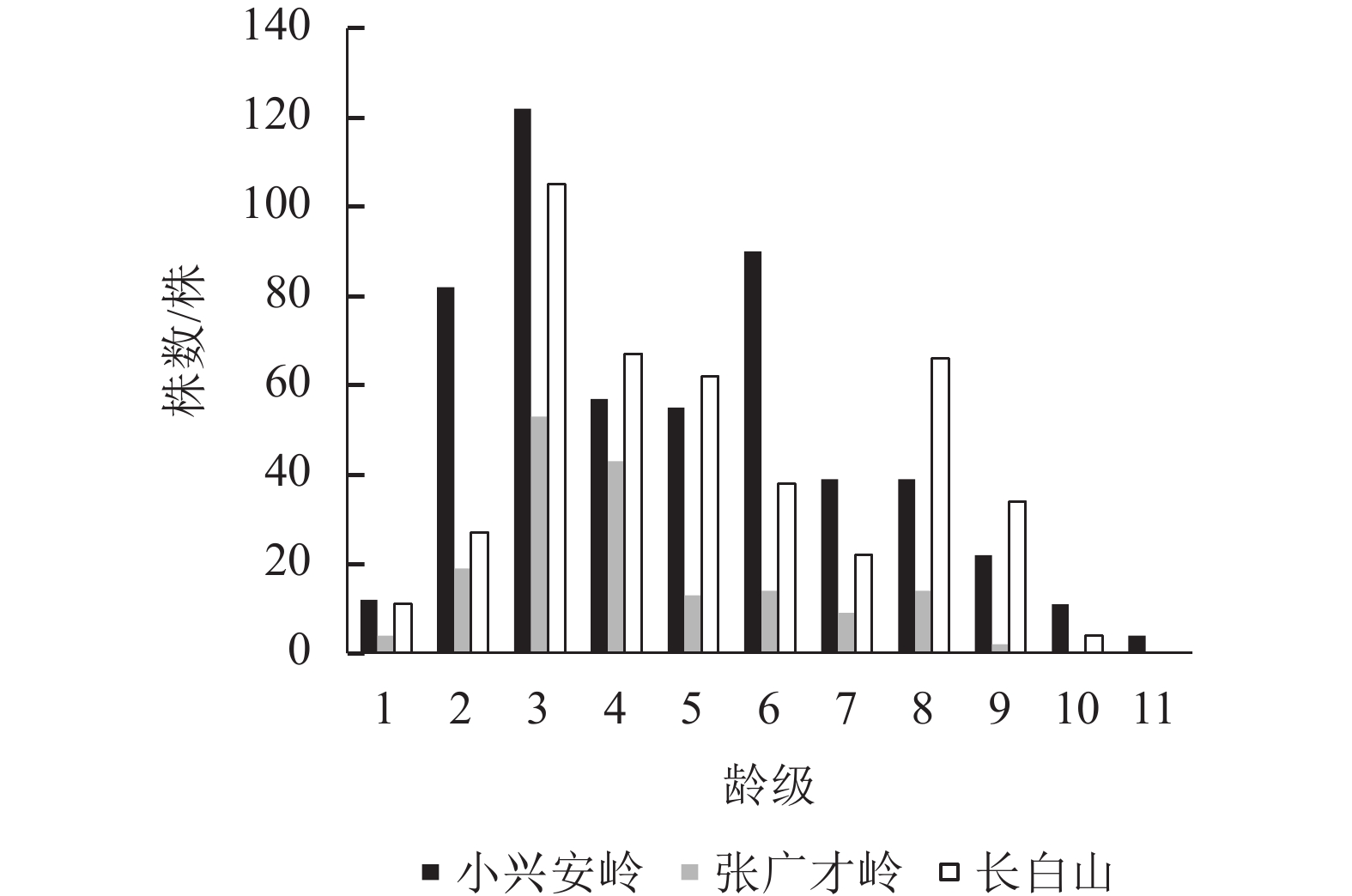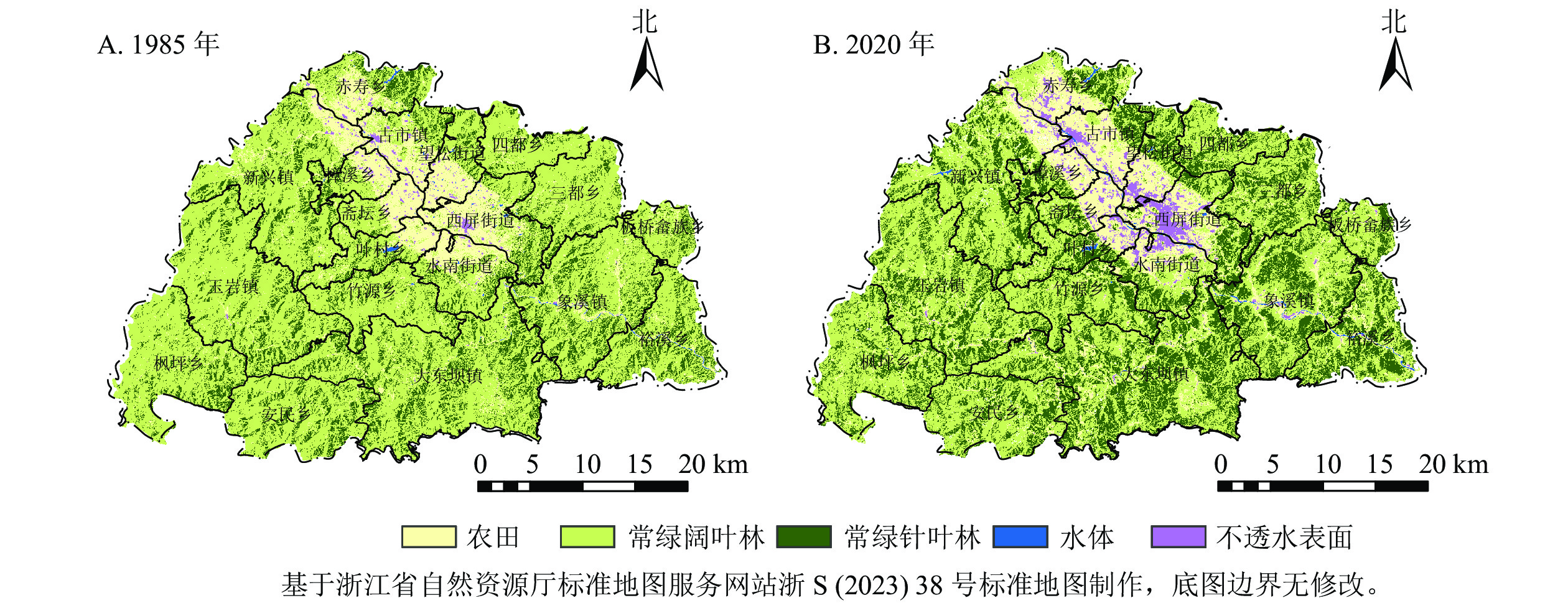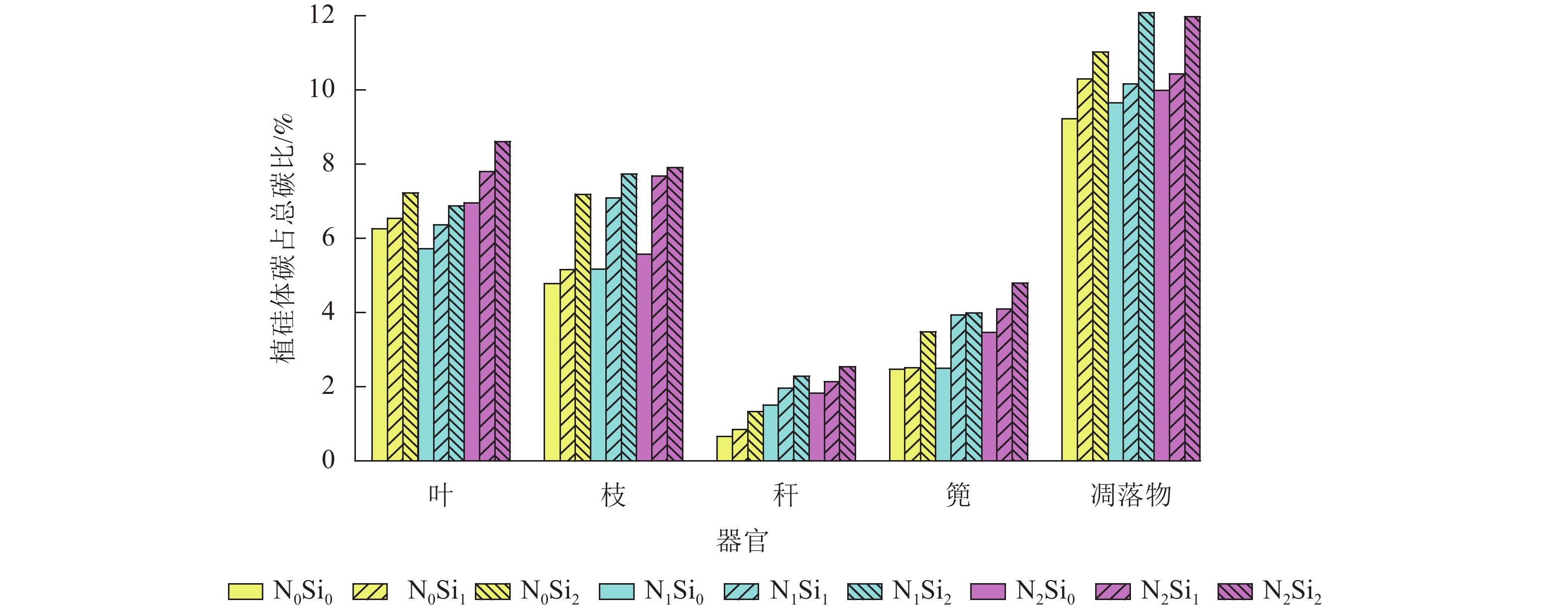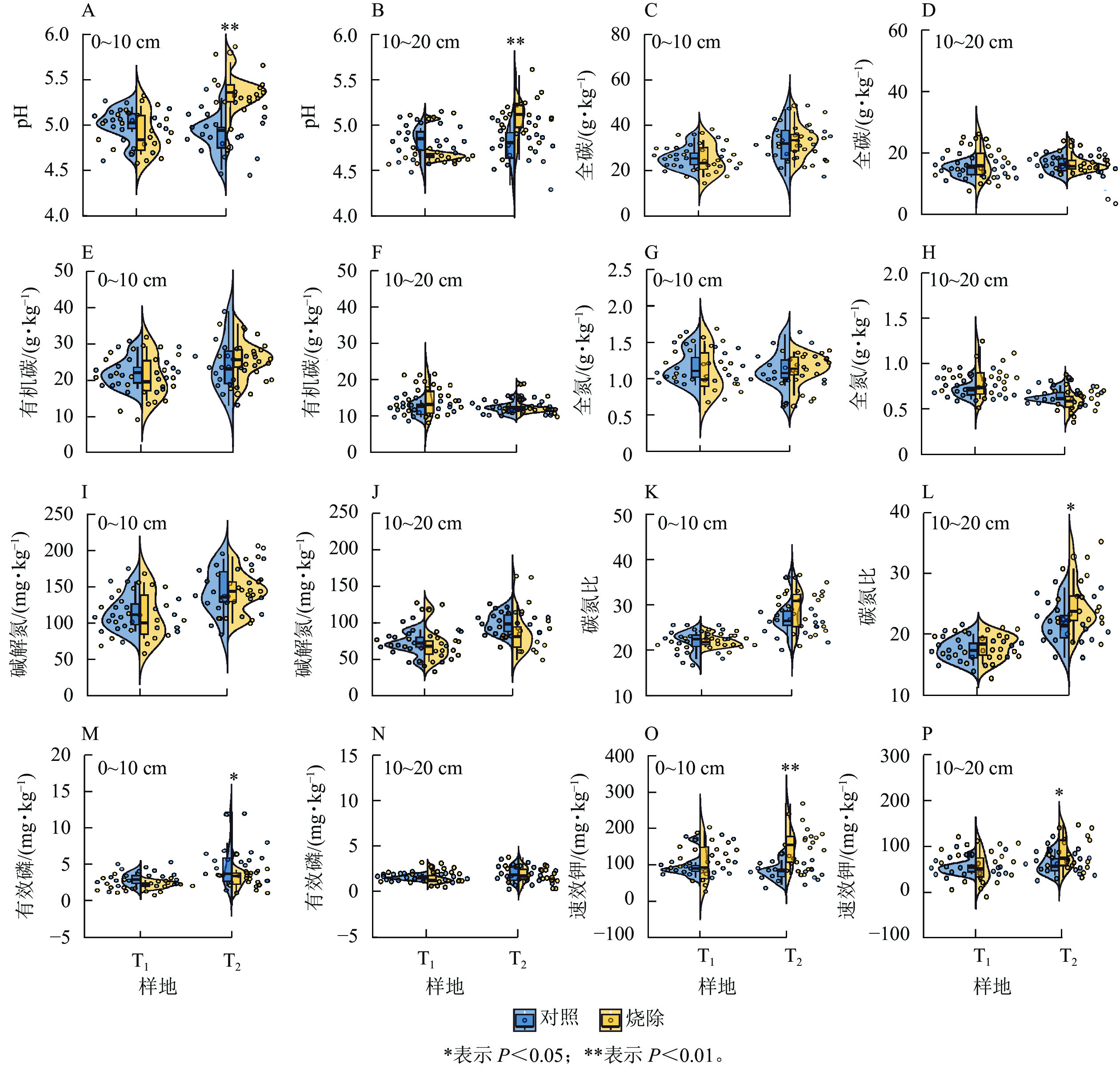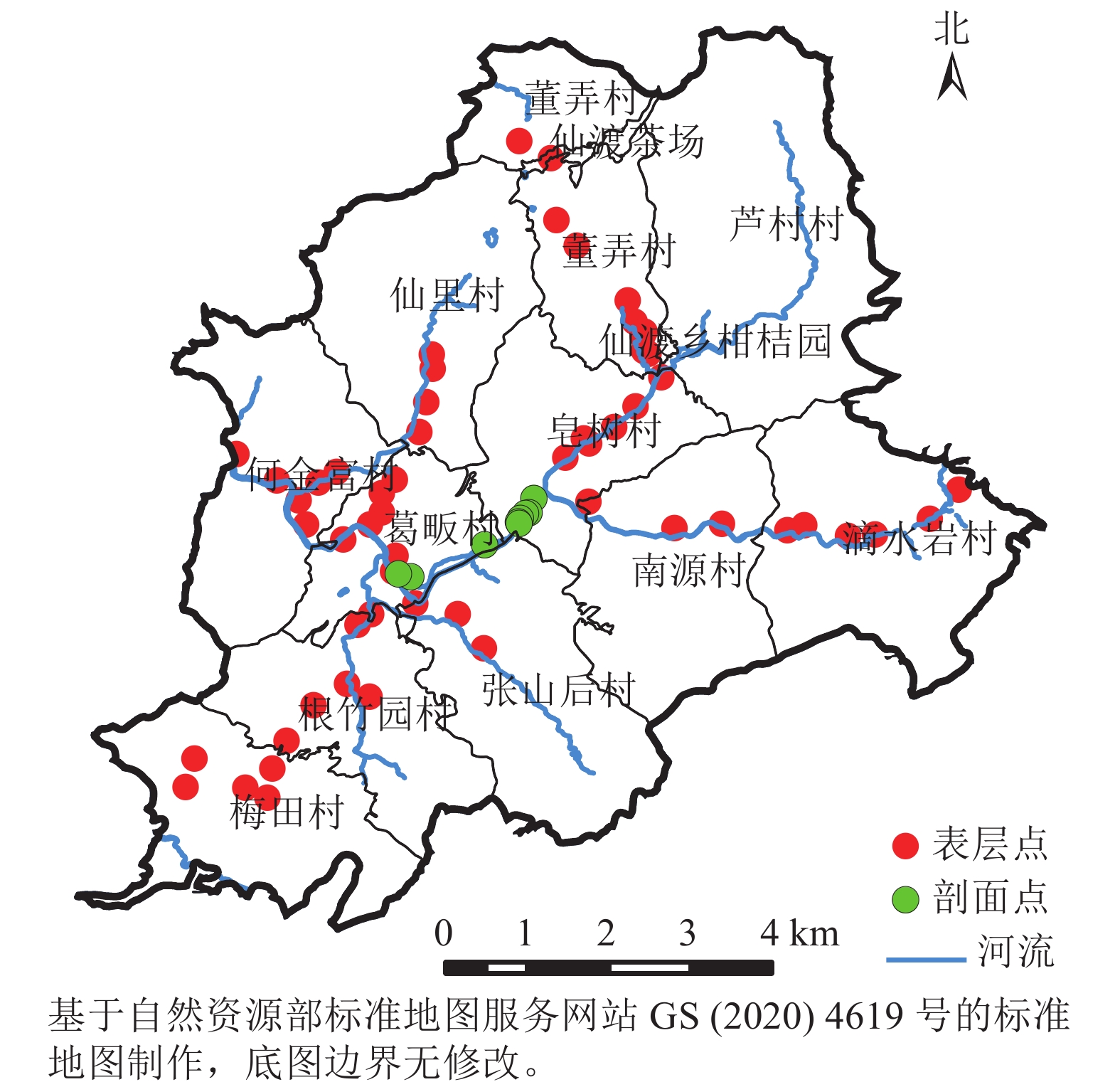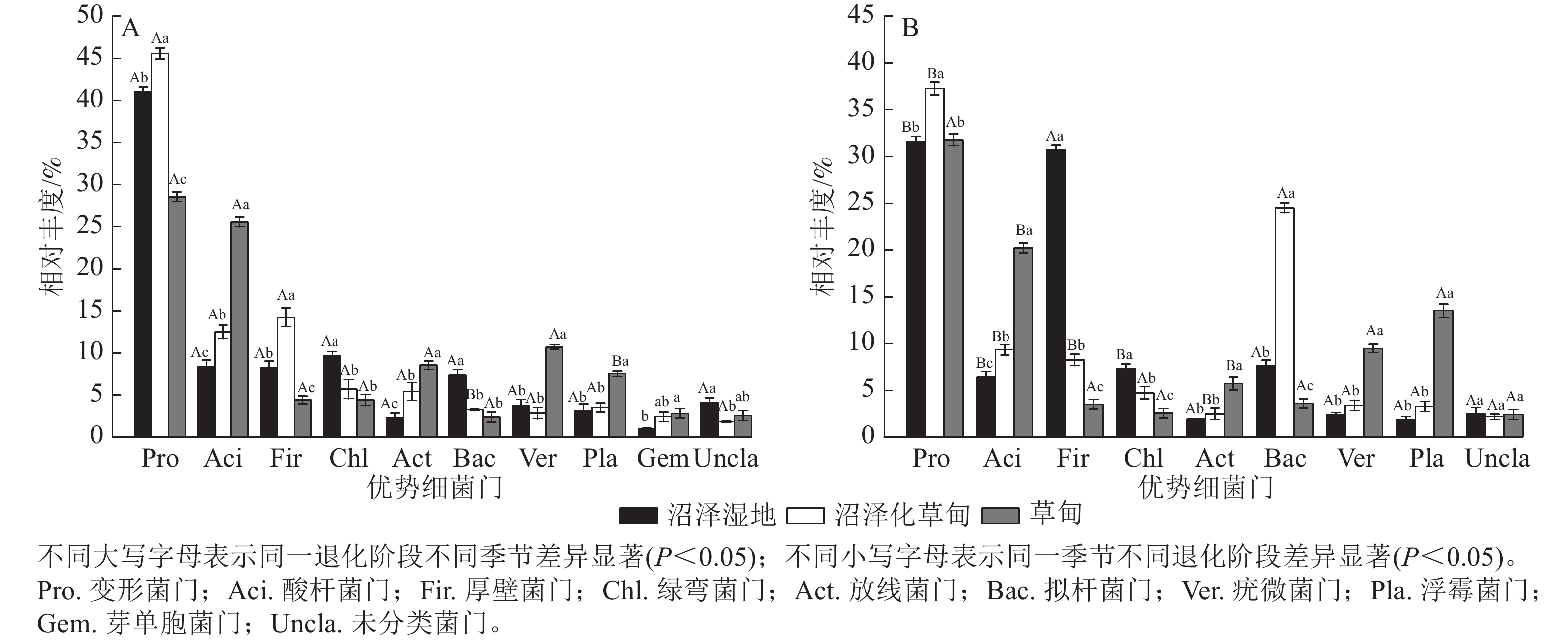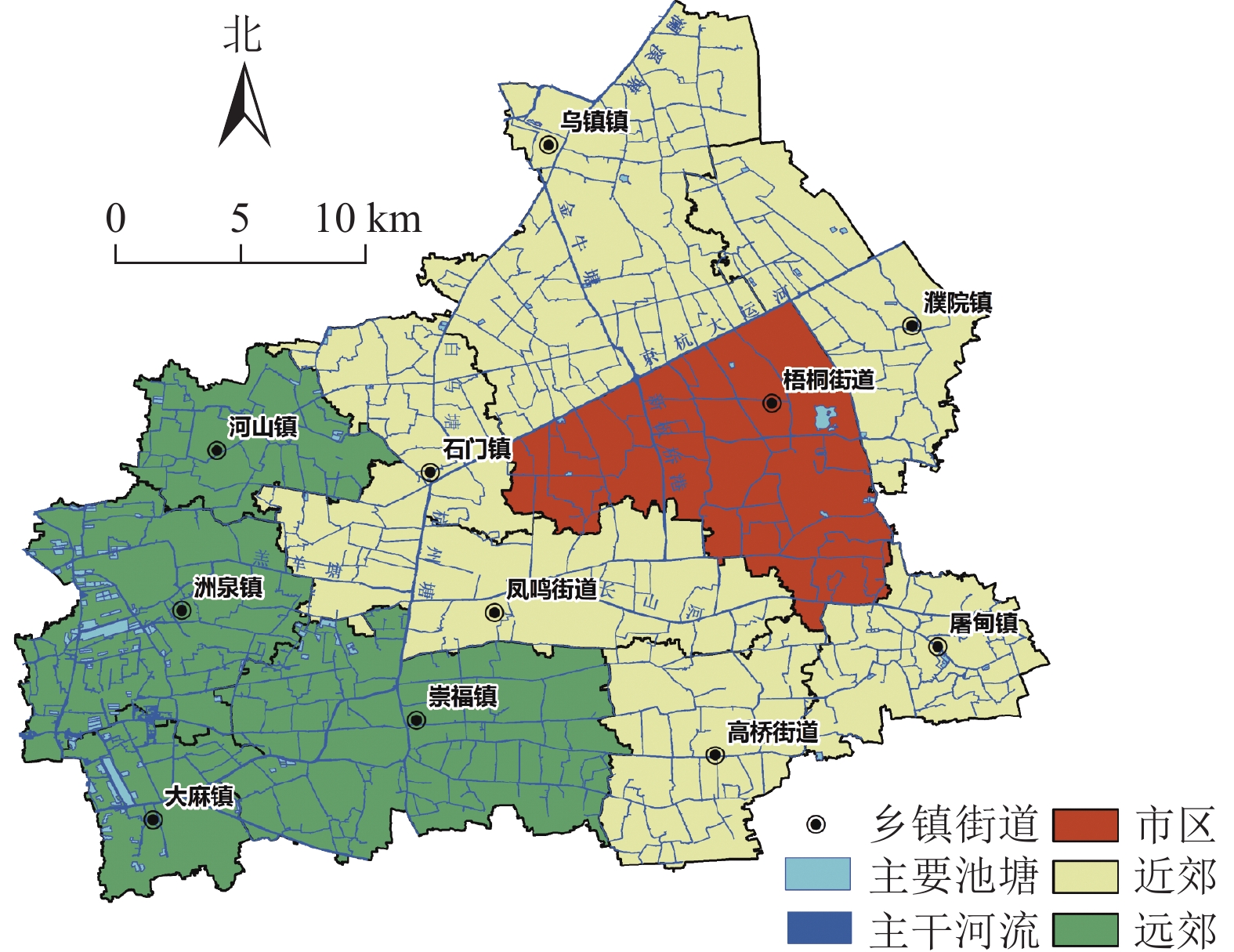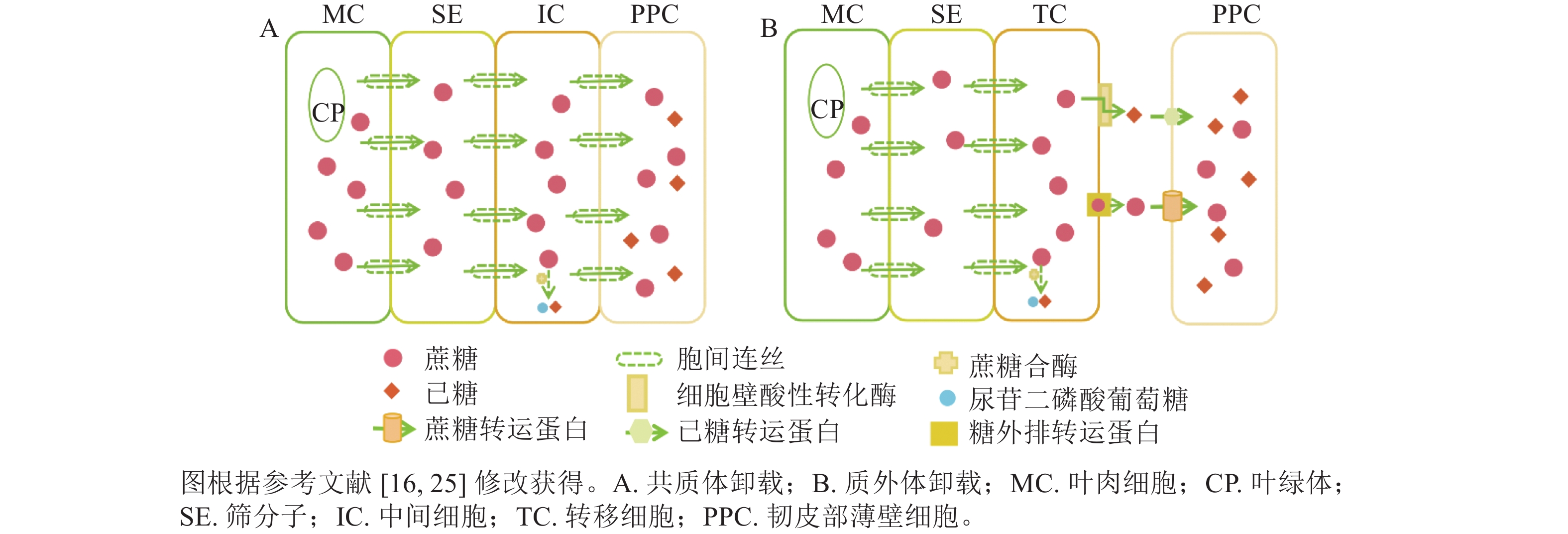2024 Vol. 41, No. 2
2024, 41(2): 223-233.
doi: 10.11833/j.issn.2095-0756.20230385
Abstract:
Objective This study aims to investigate the effects of UV-B radiation on phenolic components, antioxidant capacity and relation genes expression in Tetrastigma hemsleyanum. Method Three-year-old T. hemsleyanum seedlings were subjected to continuous UV-B radiation for 12.0 h and their phenotypes were observed at 0, 0.5, 1.0, 3.0, 6.0, and 12.0 h. With those untreated as control (ck), some other T. hemsleyanum were irradiated for 1.0 and 3.0 h (T1 and T3), and supplemented with dark treatment for 24.0 h (T1+23 and T3+21). Mass fractions of phenolic substances (total phenols and total flavonoids), antioxidant capacity, anti-stress enzyme activity, malondialdehyde (MDA) mass molar concentration in leaves were determined and transcriptome analysis was made. Result Continuous UV-B radiation had an effect on the phenotype of T. hemsleyanum. The leaves of 3-h group were partially yellowed, while the leaves of 6-h and 12-h groups were significantly yellowed and slightly curled. The mass fractions of total phenols (2.65 and 2.63 mg·g−1) and total flavonoids (7.16 and 7.30 mg·g−1) in leaves and root tubers, as well as the antioxidant capacity (86.56%) in root tubers reached the maximum in T1+23 group. Meanwhile, dark treatment after UV-B radiation promoted a significant increase in activities of catalase (CAT), peroxidase (POD) and superoxide dismutase (SOD), which reached the maximum in T1+23 group. The MDA mass molar concentration was the highest in T3+21 group (7.21 mmol·g−1). UV-B radiation and dark treatment down-regulated the expression of flavonoid synthesis pathway genes (ThF3H, ThANS, ThCHS, ThANR, etc.) and up-regulated the expression of oxidation-related regulators (CAT and SOD). Conclusion Darkness treatment after UV-B radiation increases the mass fraction of phenolic substances, antioxidant capacity and anti-stress enzymes activity of T. hemsleyanum, reaching the maximum in T1+23 group. The expression of flavonoid synthase genes is down-regulated and the expression of oxidative stress-related genes is up-regulated. [Ch, 7 fig. 2 tab. 52 ref.]
2024, 41(2): 234-242.
doi: 10.11833/j.issn.2095-0756.20230422
Abstract:
Objective For the purpose of developing storage and fresh-keep technology, this study is aimed to evaluate different post-harvest methods that target at the prevention of puffiness, a common physiological disorder that occurs in mature or post-harvest storage stages of citrus fruits (Citrus reticulata) which seriously affects its marketability. Method Ethylene and 1-methylcyclopropene (1-MCP) were used to treat the postharvest ‘Ponkan’ fruit, and the main quality indexes and puffing index, as well as the characteristics of albedo cell morphological and physiological changes were studied after treatment. Result (1) Ethylene treatment brought about an increase of soluble solid content during fruit storage, accelerated the decline of cell density, cellulose content, and pectin content of the albedo, while promoting an increase in lignin content and the activity of cell wall-degrading enzymes (cellulases, pectin esterases, and polygalacturonases). (2) 1-MCP treatment slowed down the decrease of albedo cell density and cellulose content, delaying the increase of lignin content and the activity of cell wall degrading enzymes (cellulase, pectin esterase and polygalacturonase), and therefore slowing down the rise of puffiness index. Conclusion Ethylene treatment accelerated the physiological and metabolic level of ‘Ponkan’ fruit during storage and aggravated the occurrence of puffiness whereas 1-MCP treatment inhibited the peel physiological and metabolic level during storage and alleviated the occurrence of puffiness. As a result, the peeling difficulty of the fruit can be controlled by ethylene or 1-MCP treatment during production. [Ch, 7 fig. 31 ref.]
2024, 41(2): 243-251.
doi: 10.11833/j.issn.2095-0756.20230321
Abstract:
Objective This study, with an exploration of the changes of cytology and physiological and biochemical indexes during somatic embryogenesis of Lycoris chinensis × radiate ‘Astro Girl’, which can improve the coefficient and quality of tissue culture and rapid propagation of ‘Astro Girl’, is aimed to provide technical support for the factory production of new Lycoris varieties. Method Paraffin section, enzyme-linked immunosorbent assay and ultra high performance liquid chromatography-tandem mass spectrometry (HPLC-MS/MS) were used to determine the changes of somatic embryo morphology, histology and corresponding physiological and biochemical indexes such as content of soluble starch and total protein, antioxidant enzyme activity and polyamine content during somatic embryo culture (0 − 40 d) of ‘Astro Girl’. Result (1) During the process of somatic embryogenesis, the globular embryo lasted for about 20 days from initiation to transient expansion, before it was further differentiated into heart-shaped embryo, rod-shaped embryo and cotyledon embryo with vascular bundles formed at the base of the enlarged globular embryo or heart-shaped embryo. (2) During somatic embryogenesis, significant changes occurred in the content of total protein and starch and the activity of antioxidant enzymes. The change of starch content was positively correlated with the formation of globular embryo and negatively correlated with somatic embryo morphogenesis and somatic embryo maturation, whereas the changes of total protein (TP) content, peroxidase (POD) activity and catalase (CAT) activity were positively correlated with cotyledon embryo formation but negatively correlated with cotyledon embryo maturation. The activity of superoxide dismutase (SOD) was negatively correlated with globular embryo and cotyledon embryo, but positively correlated with heart-shaped embryo and rod-shaped embryo. Such results showed that starch, protein and antioxidant enzymes which are closely related to plant physiology play an important role in somatic embryogenesis. (3) The activity of polyamine oxidase (PAO) and the content of polyamine (PAs) changed significantly during somatic embryogenesis, and the contents of putrescine (Put), spermine (Spm) and spermidine (Spd) determined the change trend of polyamine content. Polyamine content and polyamine oxidase activity mainly accumulated in the early stage of somatic embryo differentiation, which was positively correlated with globular embryo differentiation, and the changes of spermine and spermidine content were positively correlated during cotyledon embryo formation. In the mature stage of cotyledon embryo, putrescine, spermine and spermidine decreased at first and then increased, while spermine and spermidine increased at first and then decreased. Conclusion During the 0 − 40 days of somatic embryogenesis of ‘Astro Girl’, the main morphology of somatic embryo developed from proembryo, globular embryo, heart-shaped embryo and rod-shaped embryo to cotyledon embryo, among which, the physiological characteristics changed significantly, and the accumulation or consumption of starch content may be an important factor affecting the formation of globular embryo and the subsequent morphological development and maturation of somatic embryo. During the formation and maturation of cotyledon embryo, the changes of total protein content, peroxidase activity and polyamine content may play a closely joint role. The active accumulation of polyamine oxidase activity and polyamine content may be beneficial to the early development of somatic embryos. [Ch, 4 fig. 32 ref.]
2024, 41(2): 252-261.
doi: 10.11833/j.issn.2095-0756.20230196
Abstract:
Objective The objective is to analyze the synthesis, transportation and distribution of non-structural carbohydrates (NSC) in Lycoris radiata. Method 13C isotope pulse labeling method was used to study the distribution and transport pathway of newly assimilated carbon in different organs (leaves, roots, inner bulb, middle bulb and outer bulb) and NSC components (sucrose, fructose, glucose and starch). Result (1) The biomass and total carbon content were the highest in the inner bulb. The sink vitality of each organ in descending order was leaf, inner bulb, root, middle bulb and outer bulb. (2) After absorbing 13CO2, the distribution ratio of 13C in different organs from high to low was leaf, stem and root. The distribution in bulbs gradually decreased from inside to outside. The distribution ratio of 13C-labeled sucrose in different organs of L. radiata from high to low was manifested as inner bulb, leaf, middle bulb, root and outer bulb. The distribution ratio of 13C-labeled fructose and glucose ranging from high to low was leaf, inner bulb, root, middle bulb and outer bulb. The distribution ratio of 13C-labeled starch from high to low was expressed as leaf, inner bulb, middle bulb, root and outer bulb. (3) The transport of 13CO2 in L. radiata mainly involved two major pathways: horizontal and vertical, with 13C being transported more in vertical direction. (4) The distribution of 13C in NSC components was the highest in sucrose, followed by 13C-labeled fructose, while the content of 13C-labeled glucose was minimal in various parts, lower than other sugars. (5) In the process of sugar conversion and metabolism, the 13C distribution rate of fructose in leaves, roots and inner bulb was 9.6, 41.5 and 118.1 times that of glucose, respectively. The newly synthesized fructose was much more than glucose in a short time. Conclusion The distribution of newly assimilated carbon in L. radiata gradually decreases in both vertical and horizontal transport. The photosynthetic products in the leaves of L. radiata are first transported to the inner layer of bulbs, and some are first transported to the roots. The other part is transported from the inner layer to the outer layer of the bulb. At this point, the middle and outer layers of the bulb mainly serve as temporary nutrient reservoirs. Sucrose is not only the main product of photosynthesis in L. radiata leaves, but also the main form of NSC transport in L. radiata. The production of a large amount of 13C-labeled fructose in L. radiata is related to the preferential use of sucrose synthase pathway in the sucrose hydrolysis process, which also elucidates the significance of illustrates that fructose for the growth and development of L. radiata. [ Ch, 6 fig. 36 ref.]
2024, 41(2): 262-274.
doi: 10.11833/j.issn.2095-0756.20230279
Abstract:
Objective This study, with a comparison of the different floral scent compounds of different cultivars of Prunus mume, is aimed to investigate the floral composition of P. mume so as to lay a foundation for mining the key enzyme genes in the pathway of floral aroma metabolism and molecular breeding in the future. Method With 20 cultivars of P. mume from different groups selected as experimental materials, headspace solid phase microextraction method and gas chromatography-mass spectrometry (HS-SPME-GC-MS) were employed to determine the floral components of 20 cultivars of P. mume and identify the characteristic aroma substances of P. mume before an analysis was conducted of the floral components and relative content differences of P. mume in different cultivars groups whereas a cluster analysis was conducted of the cultivars in accordance with the floral components. Result A total of 43 volatiles were identified from 20 cultivars of P. mume, among which benzene/phenylpropane compounds were the most diverse and had the highest content, and their relative content in all cultivars was higher than 85%. Among the volatiles, the benzyl acetate, benzyl alcohol, eugenol, methyl eugenol, benzaldehyde and cinnamyl alcohol were the main components of P. mume flower fragrance, the number of floral compounds in Cinnabar Purple and Pink Double group was the highest, followed by that in Versicolor and Green Calyx group, and the number of floral compounds in Alboplena and Pendulous Mei group was relatively smaller. Cluster analysis showed that 20 cultivars of P. mume could be divided into 5 categories according to the types and contents of flower aroma components. Conclusion The aroma components and relative contents of different cultivars of P. mume were different, so was the contribution of different floral components to the aroma of different cultivars of P. mume. [Ch, 1 fig. 11 tab. 28 ref.]
2024, 41(2): 275-285.
doi: 10.11833/j.issn.2095-0756.20230342
Abstract:
Objective This study is aimed to identify the bZIP transcription factor family members from Phoebe bournei and investigate the response levels of its members to abscisic acid (ABA) treatment. Method A bioinformatic method was employed to identify the PbbZIPs family throughout the whole genome and to analyze its physicochemical properties, gene structure, evolutionary relationships, cis-acting elements in promoter, and the expression patterns under ABA treatment by RT-qPCR. Result A total of 63 PbbZIP genes were identified from 12 chromosomes in P. bournei, divided into 12 subfamilies with significantly different in gene structure and motifs, but highly conserved in the same subfamily. Most of the PbbZIPs were localized in the nucleus, and their encoded protein were 110 − 835 amino acid in length, −1.19 − −0.19 in hydrophobicity, and 4.48 − 11.95 in isoelectric point. The 27 pairs of PbbZIPs distributed on 12 chromosomes were featured with collinearity existence, which was the main pattern of PbbZIPs family expansion. A variety of abiotic stress-related action elements were found in the upstream promoter region of PbbZIPs, among which ABA, salicylic acid and methyl jasmonate were more abundant response elements and the genes expression of RT-qPCR revealed that 17 PbbZIPs were induced differentially by ABA signals and generally up-regulated in leaves and roots when P. bournei was treated with 2 mmol·L−1ABA for 1 − 72 h, with the relative expression of PbbZIPs in roots being generally lower than that in leaves. Conclusion The 63 PbbZIPs identified from the P. bournei genome were unevenly distributed across the 12 chromosomes and highly similar in gene sequences, whereas the chromosomal localization genetic structure and conserved motifs were evolutionarily diverse and different between subgroups. The PbbZIPs in leaves and roots responded differently to ABA treatment and got involved in the regulation of other abiotic processes. [Ch, 9 fig. 35 ref.]
2024, 41(2): 286-296.
doi: 10.11833/j.issn.2095-0756.20230278
Abstract:
Objective This study is aimed to conduct an in-depth study of the functions associated with members of the R2R3-MYB subfamily in cucumber (Cucumis sativus). Method First, an analysis was conducted of the whole cucumber genome so as to identify R2R3-MYB subfamily members. Then, bioinformatics was employed to analyze their phylogenetic relationships, physicochemical properties of proteins, chromosomal localization, gene structure, conserved motifs, and cis-acting elements, as well as the protein interactions. Result The whole cucumber genome contained 99 R2R3-MYB transcription factors with typical structural domains, and the protein sequences contained amino acids ranging from 195 to 552, with conserved motifs and amino acid sites. They were unevenly distributed on chromosomes. They were unstable proteins with the instability index of most subfamily members being greater than 40. As was shown by the analysis of cis-acting regulatory elements, most of the elements contained in the promoter regions of genes were closely related to hormone regulation, MYB binding sites, and stress. Conclusion The R2R3-MYB family members were obtained through whole cucumber genome identification, which were divided into 30 subgroups and mapped on 7 chromosomes and the upstream promoter region of this family members contained stress-related action elements. [Ch, 7 fig. 1 tab. 36 ref.]
2024, 41(2): 297-305.
doi: 10.11833/j.issn.2095-0756.20230412
Abstract:
Objective This study is aimed to clarify the structure traits of chloroplast genome and phylogenetic status of medicinal plant Wikstroemia indica, providing a scientific basis for the resource protection and sustainable utilization of W. indica. Method An Illumina high-throughput sequencing platform was employed to acquire the chloroplast genome sequence which was then assembled, annotated, compared and analyzed using bioinformatics technologies and software. Result The chloroplast genome of W. indica was an annular quadripartite molecule with a length of 149 864 bp and composed of a large single copy (LSC, 86 347 bp), a small single copy (SSC, 10 601 bp) and a couple of inverted repeat (IR, 26 458 bp) and 124 genes were annotated in the chloroplast genome. In the chloroplast genome there were a total of 24 180 codon, which were divided into 64 types of which 30 types of codon were used frequently and 29 of them ended with A/T. Altogether 93 chloroplast simple sequence repeat (SSR) were identified from the chloroplast genome with Mononucleotide being the predominate type taking up a number of 72 and the motifs formed by A/T contributing the most and obvious variations were observed in IR boundary between W. indica and closely related plants whereas sequence alignment and phylogenetic tree revealed that W. indica shared high sequence identity with W. nutans. Conclusion The chloroplast genome of W. indica exhibited typical structure of plant chloroplast genome, and possessed codon preference and several SSRs with rich polymorphism. Additionally, the chloroplast genome of W. indica showed the closest similarity to W. nutans. [Ch, 5 fig. 2 tab. 24 ref.]
2024, 41(2): 306-313.
doi: 10.11833/j.issn.2095-0756.20230371
Abstract:
Objective The study aims to explore the genetic variation in seedling growth and nitrogen fixation traits of Falcataria falcata and select fast growing families with strong nitrogen fixation ability. Method Seedlings of 1 to 6 months in 37 half-sib families from the 1st generation clonal seed orchard of F. falcata were used as materials. Indicators such as seedling height, ground diameter, relative chlorophyll content, biomass, and number of root nodules were investigated and measured. The methods of genetic variation analysis, correlation analysis and cluster analysis were used to compare growth and select seedlings. Result There was no significant difference in growth traits among 1 − 2 month seedlings in 37 half-sib families, but the height or ground diameter of 4-month seedlings in more than 16 families was significantly better than that of the mixed seeds of mother forests (ck) in Raoping County. The family heritability of seedling height and ground diameter was 0.89 − 0.90 and 0.84 − 0.86, respectively, and the genetic progression was 0.118 9 − 0.221 4 and 0.096 2 − 0.154 3, respectively, at a selection rate of 30%. There was a highly significant or significant positive correlation between different traits (P<0.01 or P<0.05). 13 families were selected, accounting for 34% of the population. Compared with the population mean, the realistic gains in seedling height and ground diameter were 27.99% and 12.73%, respectively, and the genetic gains were 24.91% and 10.69%, respectively. Compared with ck, the realistic gains were 62.47% and 41.65%, and the genetic gains were 55.59% and 34.98%, respectively. Conclusion The half-sib families of F. falcata have significant genetic variation in growth traits such as seedling height and ground diameter from 4 months of seedling age, and have a high level of family heritability and good selection potential. Based on the synergistic analysis of growth and nitrogen fixation traits, 13 excellent families with both seedling growth advantage and efficient nitrogen fixation capacity are selected. [Ch, 3 fig. 4 tab. 23 ref.]
2024, 41(2): 314-321.
doi: 10.11833/j.issn.2095-0756.20230304
Abstract:
Objective This study is aimed to establish a highly efficient system for regeneration and genetic transformation of in vitro leaves of Populus yunnanensis so as to help genetic engineering breeding research in P. yunnanensis. Method First, with P. yunnanensis leaves as explants, an investigation was conducted of the effects of different combinations of exogenous hormone concentrations on the induction of callus, adventitious bud differentiation and rooting so as to obtain regenerated seedlings of P. yunnanensis. Then, Agrobacterium tumefaciens mediated method was used to explore the effects of bacterial concentration, infection time and co-culture time on the genetic transformation efficiency of P. yunnanensis. Result The optimal medium for callus induction was 1/2 MS + 0.005 mg·L−1 thidiazuron (TDZ) + 0.010 mg·L−1 1-naphthylacetic acid (NAA), with an induction rate of 91.7%. The optimal medium for the induction of adventitious bud was 1/2 MS + 0.002 mg·L−1 TDZ + 0.010 mg·L−1 NAA, with an induction rate of 75.0% whereas the optimal medium for rooting was 1/2 MS + 0.010 mg·L−1 NAA + 0.100 mg·L−1 3-indolebutyric acid (IBA), and the rooting rate was as high as 96.7%, with an average number of 2.57 roots. The optimal concentration of transforming bacterium D(600) was 0.2, the infection time was 5 min, and the co-cultivation time was 2 days. During differentiation, the optimal concentration of cefotaxime to inhibit the growth of A. tumefaciens was 200 mg·L−1, and the optimal concentration of kanamycin in the screening medium for resistant buds was 20 mg·L−1. The regenerated plants were identified by β-glucuronidase (GUS) staining and PCR, identified 20 positive plants, with a positive transformation rate of 45.45%. Conclusion The leaf regeneration system and genetic transformation system of P. yunnanensis were successfully established. [Ch, 5 fig. 5 tab. 27 ref.]
2024, 41(2): 322-332.
doi: 10.11833/j.issn.2095-0756.20230466
Abstract:
Objective This study aims to analyze root morphological characteristics of Pinus yunnanensis seedlings after stumping at different ages, and to provide evidence for selecting suitable stump-age. method Taking P. yunnanensis seedlings aged 6, 10, 14, 18 and 30 months as materials, all seedlings were pruned to a uniform height of 5 cm. The root morphology and biomass were measured at 60, 120, 180, 240, 300, 360, 420, and 480 d after stumping, and the root structure of different seedling ages of P. yunnanensis after stumping was analyzed. Result Stumping at different seedling ages significantly affected the root morphological characteristics of P. yunnanensis seedlings (P<0.05). At 480 days after stumping, the seedlings stumped at 6 months had smaller average root diameter (0.825 mm) and root volume (4.435 cm3) compared with those stumped at 30 months, which had an average root diameter of 1.302 mm and root volume of 16.282 cm3, but the total root length was larger. The specific root length for 6 to 30-month-old stumped seedlings showed a decreasing tendency, and the root specific surface area, root tissue density, and root fineness of the seedlings stumped at 6 months were significantly greater than those of the seedlings stumped at other ages (P<0.05), showing a decreasing trend with increasing seedling age. There was no significant difference in the growth rate of average root diameter, root volume, and root biomass, while total root length, root surface area, and root biomass showed a trend of decreasing growth rate with increasing seedling age. Conclusion Younger seedlings build finer and denser root systems, which is conducive to the absorption and utilization of water and nutrients. The seedlings aged 6 months showed the best effect of stumping. [Ch, 2 fig. 5 tab. 40 ref.]
2024, 41(2): 333-342.
doi: 10.11833/j.issn.2095-0756.20230377
Abstract:
Objective This study aims to analyze the structural characteristics of wild Acanthopanax senticosus population in Northeast China, clarify its survival status and predict the future succession trend, so as to provide scientific basis for conservation, utilization and sustainable development of A. senticosus population in Northeast China. Method Survey sample plots were set up in representative habitats in Xiaoxinganling, Zhangguangcailing and Changbai Mountain and the plants in the sample plots were surveyed. Based on sample survey and data statistics, the age structure of wild A. senticosus was mapped, its static life table was compiled, survival and mortality curves and survival function curves were fitted, and survival analysis and quantitative dynamic parameters were used to predict population development trend. Result (1) The age structure of wild A. senticosus population in the three regions was similar to a “pyramid” type, and the number of young and mature plants accounted for 68.58% − 83.04% of the total number of the species and the age structure of the population was stable. (2) In the three regions, the dynamic indices of quantitative changes in the population structure (\begin{document}${V}_{{\rm{p}}n})$\end{document} \begin{document}${V'_{{\rm{p}}n}}$\end{document} Conclusion At present, the population structure of wild A. senticosus in the three regions is of a growth type, but the number of young plants is small and the development potential of the number of old individuals in the population is small. It is difficult to maintain an overall long-term stability of wild A. senticosus population. It is recommended to strengthen the precise nurturing and management of 1-year-old individuals, improve the seedling preservation rate through artificial measures, and promote the sustainable development of wild A. senticosus population. [Ch, 3 fig. 5 tab. 35 ref.]
2024, 41(2): 343-352.
doi: 10.11833/j.issn.2095-0756.20230363
Abstract:
Objective To establish a tree height-diameter model for mixed forests of Pinus massoniana and Schima superba, introduce tree species as dummy variables into the model, and consider the spatial autocorrelation and heterogeneity of residuals of the model, in order to provide theoretical basis for the construction of the tree height-diameter model of mixed forests and the scientific management of mixed forests. Method Based on the survey data of 727 groups of tree height-diameter in mixed forests of P. massoniana and S. superba in Kaiyang County, Guizhou Province, we constructed ordinary least squares (OLS), generalized additive model (GAM), linear mixed model (LMM), geographically weighted regression model (GWR), and geographically weighted regression kriging (GWRK) models for tree height-diameter-whole-forest model, on the basis of which tree species was introduced as a dummy variable, and five model residuals spatial autocorrelation and spatial heterogeneity were selected for global Moran’I, local Moran’I, and intra-block variance analyses with the coefficients of determination (R2), mean squared error (MSE), and the Akaike information criterion (AIC) to evaluate the models. Result (1) The fitting accuracies of the whole-forest base models of P. massoniana-S. superba mixed forest were OLS<GAM<LMM<GWR<GWRK in descending order. (2) The fitting accuracies of the models were higher than those of the whole-forest base models after introducing tree species as a dummy variable into the models. (3) The global Moran’ I of the residuals of the OLS and GAM models was significant at the α=0.05 level (Z>1.96), and there were more hot spots in the local Moran’I distribution maps, which showed strong spatial autocorrelation. In contrast, the global Moran’I of the residuals of the LMM, GWR and GWRK models is insignificant at the α=0.05 level (−1.96≤Z≤1.96) and there are more cold spots in the local Moran’I distribution plot, indicating that spatial autocorrelation of the model residuals has been eliminated. (4) The intra-block variance of the residuals of the five models show a tendency to increase with the lag distance, but the GWR and GWRK models have smaller intra-block variance, which can better reduce the heterogeneity of the model residual space. Conclusion The OLS and GAM models do not have high fitting accuracy and cannot eliminate spatial autocorrelation and heterogeneity of model residuals, so they are not the best choices for modeling tree height-diameter. The LMM, GWR, and GWRK models perform well in improving the model fitting accuracy and decreasing the spatial autocorrelation, but the GWR and GWRK models are more significant in decreasing the spatial heterogeneity, and they are the most appropriate of the tree height-breast diameter models. [Ch, 2 fig. 3 tab. 38 ref.]
2024, 41(2): 353-361.
doi: 10.11833/j.issn.2095-0756.20230324
Abstract:
Objective Songyang County in Zhejiang Province is rich in forest resources and has great potential for carbon sinks, and is a tertiary linkage area of Baishanzu National Park. This study aims to monitor forest disturbance and restoration in Songyang County, so as to provide an important reference for forest management in this region and ecological protection for Baishanzu National Park. Method Using the LandTrendr algorithm of the Google Earth Engine (GEE) cloud platform, as well as Landsat satellite remote sensing time series data from 1987 to 2020, the forest disturbance and restoration status in Songyang County, Zhejiang Province from 1987 to 2020 were detected, and the spatial and temporal characteristics of forest disturbance and restoration were analyzed. Result (1) The overall accuracy of the LandTrendr algorithm in detecting forest disturbance and restoration reached 82%, and the production accuracyand user accuracy of forest disturbance and restoration were both higher than 80%, indicating that the monitoring of forest disturbance and restoration in Songyang County was effective. (2) The total area of forest disturbance and restoration in Songyang County reached 148.14 and 236.86 km2, accounting for 12.74% and 20.37% of the forest land area, indicating a net increase in forest area in Songyang County from 1987 to 2020. (3) Forest changes in Dadongba Township, Banqiao She Township, Xinxing Township and Yuyan Township in Songyang County were relatively frequent, and the area of forest disturbance and restoration was higher than that in other townships. In particular, the forest area of Dadongba Township changed the most, with an increase of 20.04 km2. Conclusion The LandTrendr algorithm based on the GEE cloud platform has achieved precise monitoring of forest disturbance in this county. The overall forest area in Songyang County has shown an increasing trend in the past 30 years. [Ch, 3 fig. 3 tab. 46 ref.]
2024, 41(2): 362-368.
doi: 10.11833/j.issn.2095-0756.20230167
Abstract:
Objective This study aims to clarify the spatial distribution of Monochamus saltuarius and Arhopalus rusticus on Pinus koraiensis from the perspective of vertical space, and explore the interspecific relationship between these two species, so as to provide theoretical basis for their control measures. Method Adults of M. saltuarius and A. rusticus were simultaneously detected in P. koraiensis forest in Fushun, Liaoning Province, and both species of beetle larvae were found on the same P. koraiensis tree. Taking P. koraiensis as the habitat resource of longhorn beetle larvae and the vertical height of P. koraiensis as the resource sequence, P. koraiensis affected by longhorn beetles was selected using 40 cm as a unit to study the morphological characteristics, distribution location, niche width and niche overlap of M. saltuarius and A. rusticus larvae. Result The distribution of M. saltuarius larvae on P. koraiensis was (87.20±8.45) heads per plant, and that of A. rusticus larvae was (24.40±2.37) heads per plant. The distribution of M. saltuarius larvae was positively skewed on P. koraiensis, with the largest distribution of (16.40±2.38) heads per plant at 80 − 120 cm above ground, significantly higher than the number below 80 cm and above 120 cm (P<0.05). A. rusticus larvae were evenly distributed in the aboveground parts of the affected trees, with the most abundant at a height of 200 − 280 cm, accounting for 33.63% of the total number of larvae, significantly higher than the number below 120 cm, 160 − 200 cm and above 320 cm (P<0.05). No larvae of these two pests were found in the underground parts of damaged P. koraiensis. There was a certain difference in niche width between M. saltuarius and A. rusticus larvae, with values of 0.694 4 and 0.757 6, respectively, and a niche overlap value of 0.804 6. Conclusion M. saltuarius larvae are mainly distributed in the middle and lower parts of the trunk of P. koraiensis, while A. rusticus larvae are evenly distributed at various heights of the trunk. The ecological niche overlap between the two is relatively high on P. koraiensis, and the degree of similarity in ecological characteristics is relatively high, indicating a high competitive relationship between the two in P. koraiensis forest to a certain extent. [Ch, 2 fig. 25 ref.]
2024, 41(2): 369-378.
doi: 10.11833/j.issn.2095-0756.20230460
Abstract:
Objective This study aims to investigate the response of phytolith and phytolith-occluded organic carbon (PhytOC) formation to exogenous nitrogen (N) and silicon (Si), and study the effect of exogenous N and Si addition on PhytOC sequestration capacity of Ph. edulis. Method N-Si two factor three level orthogonal cultivation experiment was designed [CO(NH2)2: 0(N0), 250(N1), 500(N2) mg·kg−1, Na2SiO3: 0(Si0), 75(Si1), 150(Si2) mg·kg−1], and samples of leaves, branches, culm, culm stump and litter were collected to analyze PhytOC content in different organs under different treatments. Result With the increase of Si addition, PhytOC content of different organs and litter showed an upward trend. PhytOC contents in different treatments of leaves, branches, culm, culm stump, and litter were 3.15 − 4.68, 2.10 − 3.47, 0.30 − 1.18, 1.09 − 2.15 and 3.21 − 4.63 g·kg−1, respectively, and all showed the highest content of PhytOC in N2Si2 treatment [CO(NH2)2: 500 mg·kg−1, Na2SiO3: 150 mg·kg−1], while the lowest content of PhytOC in N0Si0 treatment [CO(NH2)2: 0 mg·kg−1, Na2SiO3: 0 mg·kg−1]. The results of the difference significance analysis showed that PhytOC content showed significant differences (P<0.05) between N0Si1, N0Si0 and N2Si2 treatments in culms. The correlation analysis results showed that there was a highly significant positive correlation between PhytOC and Si (R2=0.481 8, P<0.01), as well as between PhytOC and phytolith (R2=0.463 2, P<0.01). There was a highly significant negative correlation between PhytOC and C (R2=0.318 3, P<0.01). Conclusion Exogenous N addition contributes to the absorption of Si and the accumulation of organic matter in Ph. edulis, while Si addition helps to increase the content of phytolith and PhytOC, as well as the proportion of PhytOC to C. [Ch, 1 fig. 9 tab. 36 ref.]
2024, 41(2): 379-386.
doi: 10.11833/j.issn.2095-0756.20230417
Abstract:
Objective This study aims to analyze the impact of evaluate prescribed burning and intervals on soil chemical stoichiometry of carbon (C), nitrogen (N), phosphorus (P), and potassium (K) in Pinus yunnanensis forest. Method The study object was P. yunnanensis forest in Xinping Zhaobi Mountain, Yuxi in central Yunnan Province. Soil samples of 0 − 10 and 10 − 20 cm soil layers were collected separately from unburned plots (control), plots of 1 year after prescribed burning (T1) and plots of 3 years after prescribed burning (T2), respectively, and the mass fractions of soil C, N, P, and K were measured. The impact of prescribed burning on soil stoichiometry in P. yunnanensis forest was studied. Analysis of variance (ANOVA), Spearman’s correlation analysis and principal component analysis (PCA) were used to investigate the effects of different burning intervals on the soil stoichiometry. Result Compared with the control, there was no significant change in soil pH in both soil layers (0 − 10 and 10 − 20 cm) of T1 plot, while there was a significant increase in soil pH in both layers of T2 plot (P<0.01). In the 0 − 10 and 10 − 20 cm soil layers of T1 and T2 plots, there was no significant variation in total carbon (TC), organic carbon (SOC), total nitrogen (TN), and hydrolysable nitrogen (AN). The available phosphorus (AP) in the 0 − 10 cm soil layer of T2 plot significantly decreased (P<0.05), while the available potassium (AK) in both soil layers significantly increased (P<0.05). The soil carbon-to-nitrogen (C/N) ratio significantly increased only in the 10 − 20 cm soil layer of T2 plot (P<0.05). Conclusion The impact of the prescribed burning on the quality fraction of soil nutrients in the study area is influenced by such as factors burning interval and soil depth. Both interval time after prescribed burning has no significant impact on C and N contents of soil in P. yunnanensis forest. However, burning has a larger effect on soil pH, C/N ratio, AP, and AK. [Ch, 3 fig. 3 tab. 34 ref.]
2024, 41(2): 387-395.
doi: 10.11833/j.issn.2095-0756.20230228
Abstract:
Objective This study, with an investigation of the dynamic characteristics of 0 − 500 cm soil moisture in the restoration process of artificial forests in the loess region of western Shanxi Province, is aimed to provide theoretical basis for improving soil water environment of plantation and realizing forest water balance. Method First, with five typical plantations (Robinia pseudoacacia, Platycladus orientalis, Pinus tabuliformis, R. pseudoacacia-Platycladus orientalis, R. pseudoacacia-Pinus tabuliformis) selected as the research objects, oil drill drying method was employed to measure the soil moisture content of 0 − 500 cm before an anlysis was conducted of the vertical distribution and dynamic change characteristics of soil moisture in artificial forests. Result The average soil water content of plantations from large to small is Platycladus orientalis>R. pseudoacacia-Platycladus orientalis> Pinus tabuliformis>R. pseudoacacia-Pinus tabuliformis> R. pseudoacacia, showing a significant difference in the soil content and that precipitation and soil texture were the main factors affecting soil water content in plantations (P<0.05). Vertically, the variation degree of soil water content was moderate, and the variation coefficient decreased with the increase of soil depth with the variation of soil water content of each plantation becoming steady at a depth of about 360 cm whereas the artificial vegetation mainly affected the soil water in the range of 0 − 360 cm with the water variation of R. pseudoacacia forest being the highest, and that of Platycladus orientalis forest being the most stable. The vertical layers of soil water in the plantation were divided into exchange layer, use layer, regulation layer and stability layer by using the ordered clustering method with some differences in the depth of the layers among different stands. Conclusion The artificial forest land can reduce soil moisture to some extent in the study area and the consumption of deep soil water increases with the occurrence of drought in R. pseudoacacia, Pinus tabuliformis, R. pseudoacacia-Pinus tabuliformis, especially R. pseudoacacia forest. Therefore, it is suggested that during the construction of forestry ecological engineering, efforts should be made to reduce the planting of R. pseudoacacia forest and increase the planting of Platycladus orientalis in an appropriate manner, as well as transform the existing R. pseudoacacia forest with poor soil water status into a mixed forest, so as to improve the soil water environment and achieve forest water balance. [Ch, 5 fig. 2 tab. 28 ref.]
2024, 41(2): 396-405.
doi: 10.11833/j.issn.2095-0756.20230389
Abstract:
Objective The heavy metal contamination of farmland in one town of Liandu District, was comprehensively mapped through soil sample collection and analysis, providing a scientific basis for subsequent comprehensive soil safety management and comprehensive pollution management. Method The principal component analysis (PCA), single-factor pollution index method (Pi), the Nemero index method (Pc), the land accumulation index method (Igeo), the potential ecological risk index method (IR) and ecological risk early warning index (IER) were used to analyze pollution assessment, and source analysis of heavy metal pollution in the study area. Result The exceedance rates of Cd and Pb (risk screening value) were 60.71% and 39.29%, respectively, but both were lower than the risk control value of soil pollution on agricultural land. The average value Pi of Cd was 1.31, indicating a slightly polluted level, while Pi value of the other heavy metals was less than 1, indicating in the clean. Pc value was 1.10, indicating a slightly polluted level. The Igeo value of Cd and Pb was 1.74 and 0.79, indicating in moderate pollution and no pollution-moderate pollution respectively, the rest of the heavy metals was in the clean. The average potential ecological hazard coefficient \begin{document}$E_{\rm{r}}^i $\end{document} Conclusion The soil in the study area is generally slightly polluted. Cd and Pb are the most important ecological elements in agricultural soils, and subsequent treatment and dynamic detection should be increased to ensure the safety of agricultural products. [Ch, 4 fig. 6 tab. 37 ref.]
2024, 41(2): 406-418.
doi: 10.11833/j.issn.2095-0756.20230331
Abstract:
Objective This study aims to explore the spatiotemporal dynamic characteristics of soil bacterial structure and diversity in plateau degraded wetlands, so as to provide key data support for understanding the response process and mechanism of soil microbial communities to plateau wetland degradation. Method Illumina high-throughput sequencing technology was used to detect the dry and wet seasonal changes of soil bacterial community composition and diversity during different wetland degradation stages (swamp wetlands, swamp meadows, and meadows) in the Napahai Plateau. Result (1) A total of 10 phyla and 21 genus of soil bacteria were detected, dominated by Proteobacteria and unclassified genera, with relative abundance of 35.92% and 20.64%, respectively. (2) Compared with native swamp wetlands, the relative abundance of Proteobacteria and Acidobacteria in swamp meadows increased by 14.06% and 47.72%, respectively, while that of Chloroflexi significantly decreased by 38.54% (P< 0.05). The relative abundance of Acidobacteria, Actinobacteria, Verrucomicrobia and Planctomycetes in meadows increased by 210.15%, 231.37%, 229.55% and 315.22%, respectively. The relative abundance of above phyla was greater in the dry season than in the wet season. The relative abundance of Firmicutes in swamp meadows significantly increased by 72.38% in the dry season and decreased by 73.17% in the wet season (P< 0.05). The relative abundance of Bacteroidetes in meadows significantly decreased by 55.50% in the dry season and increased by 223.54% in the wet season (P<0.05). (3) The Shannon index of swamp meadows and meadows significantly increased compared with native swamp wetlands (P<0.05). The Shannon indices in swamp wetlands and marsh meadows were higher in the wet season than in the dry season, while those in meadows showed an opposite pattern. (4) Mantel test indicated that the composition of bacterial community structure in the dry season was regulated by soil pH and the concentrations of nitrogen, phosphorus and potassium, while in wet season it was mainly regulated by soil water content, organic matter, nitrogen, phosphorus and pH. The Pearson correlation analysis showed that the controlling factors affecting bacterial diversity in the dry season were soil water content, organic matter, nitrogen and pH, while those in the wet season were soil phosphorus and potassium and carbon nitrogen ratio. Conclusion The degradation of plateau wetlands leads to a decrease in soil moisture and pH, which in turn affects the nutrient status of soil carbon, nitrogen, phosphorus, and potassium, ultimately regulating the dry and wet season changes in soil bacterial community composition and diversity. [Ch, 4 fig. 4 tab. 47 ref.]
2024, 41(2): 419-428.
doi: 10.11833/j.issn.2095-0756.20230288
Abstract:
Objective Tongxiang City of Zhejiang Province is a typical “canal town in south of the Yangtze”. Its water system has been greatly disturbed by human activities. Assessing the changes of the water system in Tongxiang is of vital importance to optimize the water pattern and enhance the sustainable development. Method Based on six multi-source remote sensing images and land use survey data from 1975, 1998, 2005, 2012, 2016 and 2019, the water system data were obtained by visual interpretation method. The quantitative changes in the number, structure, shape, function, and spatial distribution of rivers and ponds in Tongxiang since 1975, were studied using river network water system indicators, landscape pattern indices, and spatial overlay analysis. Result (1) The length and area of rivers in Tongxiang increased before 2005, declined sharply during the period of rapid urbanization, and recovered rapidly after 2016. The length and area of Class-I rivers increased in all phases, but the tributaries changed significantly. (2) The river network density, tributary development coefficient, and fractal dimension increased first, then declined, and finally increased rapidly throughout the process. The river water surface rate continued to grow but the growth rate stagnated significantly during the period of rapid urbanization. The ring degree of river network and the actual integration degree fluctuated continuously and reached its peak in 2016. (3) The variation of river network density in suburban and exurbs was much larger than that of urban areas. Before 2005, the changes of water surface rate were larger in urban area than that in exurbs and suburbs. But during the rapid urbanization period, the changes of water surface rate were larger in urban area than that of suburbs and exurbs. The changes of tributary development index was not significant in exurbs. (4) The areas of pond experienced the same process as that of the river. It first increased, then decreased and finally increased rapidly. And the structure of the pond was constantly changing. The proliferation of farming ponds was the main factor in the change of pond area. The shape of the pond became regular during the development, and its distribution gathered, then dispersed, and finally reconnected. Large-scale aggregation of the pond occurred in in the western of exurbs. Conclusion The changes in the water system of Tongxiang in different periods have been greatly influenced by urban development policies, mainly including urbanization development, agricultural structure adjustment, ecological governance, and restoration, and showed obvious periodicity. The characteristics of changes in plain water network cities of the same type are similar and different. [Ch, 3 fig. 8 tab. 36 ref.]
2024, 41(2): 429-436.
doi: 10.11833/j.issn.2095-0756.20230307
Abstract:
Objective This study, with an investigation of the production process and application fields of activated charcoal of Bambusa sinospinosa, is aimed to make full use of B. sinospinosa, improve its utilization rate, and improve its added value. Method First, with B. sinospinosa charcoal used as the raw material, steam activation method as well as single factor experiment were employed to explore the effect of temperature, time, steam vapour amount on the yield of B. sinospinosa activated charcoal and its adsorption performance. Then, Fourier infrared absorption spectrometer (FTIR), X-ray diffractometer (XRD), specific surface area and porosity analyzer (BET), scanning electron microscope (SEM) and other testing instruments were utilized to test and characterize the prepared activated charcoal of B. sinospinosa. Result (1) The activation process of the B. sinospinosa activated charcoal was optimal when activation temperature was 875 ℃, activation time was 2.0 h while steam vapour amount was 0.50 L·h−1 under which the yield of activated carbon was 29.07%, the strength was 97.68%, the adsorption value of iodine was 1 235.03 mg·g−1, and the methylene blue adsorption value was 276 mg·g−1, making a favorable adsorption performance. (2) The infrared absorption spectra showed that the absorption peaks started to weaken at 3 130, 3 010 and 1 670 cm−1 until they disappeared at 876, 809 and 747 cm−1 but the main peaks persisted; XRD analysis showed that the activated carbon contained graphite α-axis structure and as shown by surface area test and electron microscope observation, the pore volume and pore size of activated carbon activated by the optimal process were developed, with the total pore volume, the micropore volume, the average pore size and the BET specific surface area being 0.489 cm3·g−1, 0.388 cm3·g−1, 23.378 nm, and 837.005 m2·g−1 respectively. Conclusion The B. sinospinosa activated charcoal prepared by the optimal activation process had good performance and could be used on various occasions such as adsorption and decontamination. [Ch, 5 fig. 1 tab. 27 ref.]
2024, 41(2): 437-446.
doi: 10.11833/j.issn.2095-0756.20230427
Abstract:
Phloem unloading contains a series of complex processes. Phloem unloading plays an important role in the transportation and distribution of assimilates in horticultural plants (fruit trees, vegetables, ornamental plants). This study summarizes the main ways of phloem unloading, and focuses on the main research results of phloem unloading in the growth and development of horticultural plants, including: (1) the main sugar substances transported by phloem; (2) phloem unloading mode; (3) research approaches for phloem unloading; (4) research on phloem unloading in horticultural plants. The key enzymes and sucrose transporters involved in phloem unloading process need further clarification with in-depth research combining the emergence of new technologies, which will help to further elucidate the underlying molecular regulation mechanism of phloem unloading during the key economic and ornamental traits formation in horticultural plants, as well as to provide new ideas for detail research on phloem unloading in other plants. [Ch, 1 fig. 1 tab. 75 ref.]
Phloem unloading contains a series of complex processes. Phloem unloading plays an important role in the transportation and distribution of assimilates in horticultural plants (fruit trees, vegetables, ornamental plants). This study summarizes the main ways of phloem unloading, and focuses on the main research results of phloem unloading in the growth and development of horticultural plants, including: (1) the main sugar substances transported by phloem; (2) phloem unloading mode; (3) research approaches for phloem unloading; (4) research on phloem unloading in horticultural plants. The key enzymes and sucrose transporters involved in phloem unloading process need further clarification with in-depth research combining the emergence of new technologies, which will help to further elucidate the underlying molecular regulation mechanism of phloem unloading during the key economic and ornamental traits formation in horticultural plants, as well as to provide new ideas for detail research on phloem unloading in other plants. [Ch, 1 fig. 1 tab. 75 ref.]






